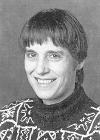Jean Taylor

1944 -
Jean Taylor was born in San Mateo, California, one of three children of a lawyer and a high school gym teacher. She had never been east of the Rocky Mountains when she left California to attend Mount Holyoke College in Massachusetts. She received her A.B. in chemistry from Mount Holyoke in 1966, graduating first in her class.
Taylor returned to California to enter the graduate program in chemistry at the University of California at Berkeley. Encouraged by some friends in the university hiking club, however, she also audited courses in algebraic topology and differential geometry. Although she switched her emphasis to mathematics, Taylor still earned her master's degree in physical chemistry in 1968. She then left Berkeley to marry her boyfriend, a mathematician who had gone to study in England. In 1971 she earned a second master's degree in mathematics from the University of Warwick.
Taylor returned to the United States to begin a doctoral program in mathematics at Princeton. She received her Ph.D. in 1973 under the supervision of Frederick J. Almgren, Jr. Her dissertation on "Regularity of the Singular Set of Two-Dimensional Area-Minimizing Flat Chains Modulo 3 in R3" solved a long standing problem about length and smoothness of soap-film triple function curves. It was published in Inventiones Mathematicae, Vol. 22 (1973), pp.119-159 [Abstract].
Upon her graduation from Princeton, Taylor joined the faculty of mathematics at Rutgers University as an assistant professor. She also married Frederick Almgren in October 1973. Taylor remained at Rutgers for her entire professional career, rising through the ranks to Professor of Mathematics in 1982. She retired in 2002. Taylor has authored over 90 publications and given over 150 invited lectures both in the United States and abroad. She has been elected a Fellow of the American Association for the Advancement of Science (AAAS), the Association for Women in Science, and the American Academy of Arts and Science. Taylor served as a Vice-President of the American Mathematical Society from 1995-1997, as a member of the Board of Directors of AAAS from 1995-1999, and in 1999 began a two year term as President of the Association for Women in Mathematics.
Taylor's research has focused on problems related to soap bubbles and crystals, and how they evolve under various physical laws. She has done pathbreaking work in the mathematics of minimal surfaces. She is well known for her Scientific American article on "The Geometry of Soap Bubbles and Soap Films" written in 1976 with her husband, Fred Almgren. Taylor has been described as an "experimental mathematician" who does experiments as a motivation for ideas, but then tries to prove that what she sees is what you have to get. Her recent research has included interdisciplinary, joint work with materials scientists, particularly with a group at the National Institute for Standards and Technology. She is interested in developing and understanding mathematical models for crystal growth.
When not involved in mathematics, Jean Taylor spends many hours as a rock climber and accomplished mountain hiker, a hobby that began in college. She and her husband, who died in February 1997, raised three children. Robert Almgren is a mathematician at the University of Chicago. Ann Almgren works as a scientist in the field of computational fluid dynamics at the Lawrence Berkeley National Laboratory. The youngest daughter, Karen, was a mathematics major at the Massachusetts Institute of Technology.
References
- Albers, Donald J. "Still Questioning Authority: An Interview with Jean Taylor," The College Mathematics Journal, Vol 27, No. 4 (September 1996), 250-266. [Available at JStor (subscription required)]
- Kanigel, Robert. "Bubble, Bubble: Jean Taylor and the Mathematics of Minimal Surfaces," The Scientist, May/June 1993, reprinted in Math Horizons, Mathematical Association of America, September 1994, 5-11.
- Ruopp, Faye Nisonoff. "Jean Taylor," in Notable Women in Mathematics: A Biographical Dictionary, Charlene Marrow and Teri Perl, Editors, Greenwood Press (1998), p.252-257.
- What's Happening in the Mathematical Sciences, Volume 1, 1993, American Mathematical Society, 31-34.
- Peterson, Ivars. The Mathematical Tourist, W. H. Freeman and Company, 1988, p.61-70.
- Jean Taylor, "In Her Own Words," AMS Notices, Vol. 38, No. 7, Sept. 1991, pp. 702-706.
- MathSciNet [subscription required]
- Author Profile at zbMath
- Mathematics Genealogy Project
